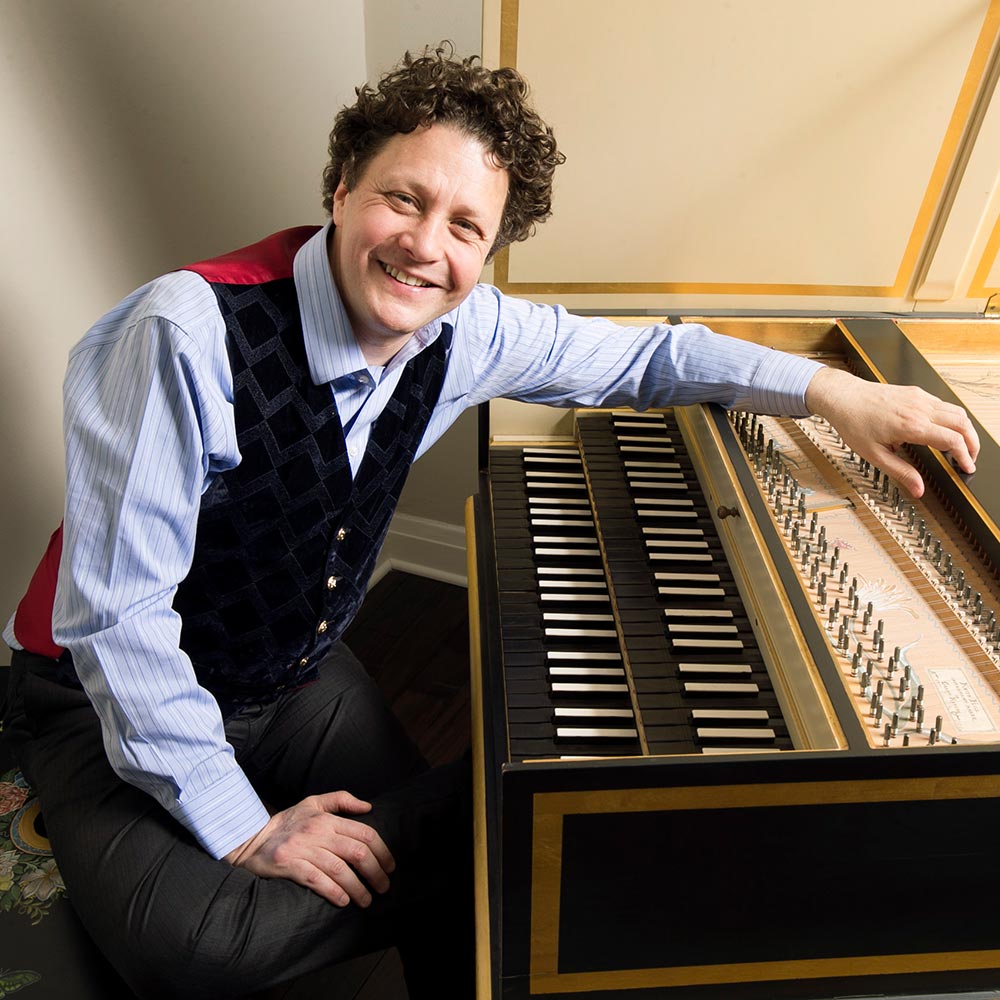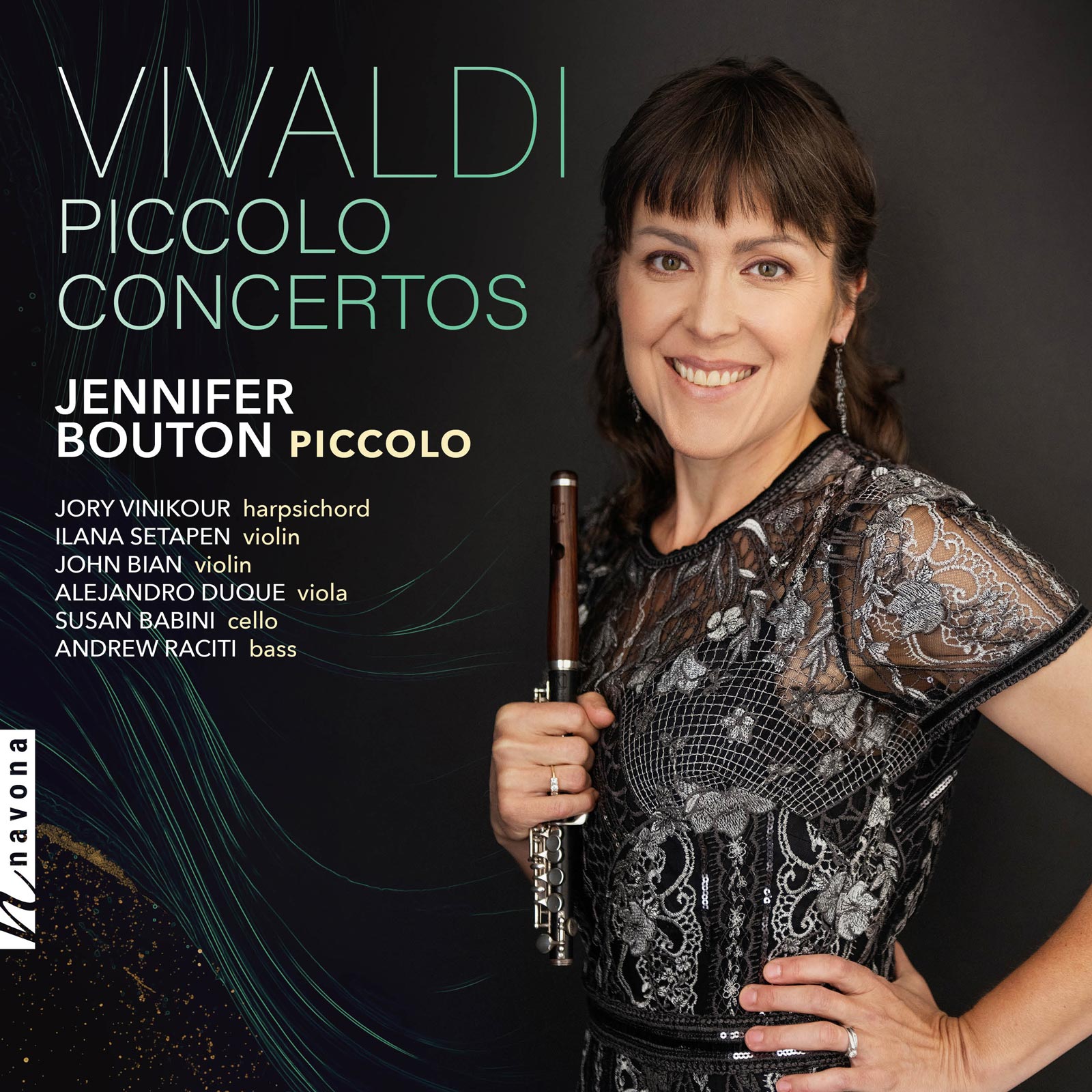Vivaldi Piccolo Concertos
Antonio Vivaldi composer
Jennifer Bouton piccolo
Jory Vinikour harpsichord
Ilana Setapen violin
John Bian violin
Alejandro Duque viola
Susan Babini cello
Andrew Raciti bass
Jennifer Bouton’s VIVALDI PICCOLO CONCERTOS is the first complete recording of the concerti by an American piccoloist. Bouton possesses a mastery over these works, having performed the most famous and beloved C Major concerto (RV 443) numerous times, notably with the Milwaukee Symphony and Nicholas McGegan in 2023.
In recording the complete set of works for sopranino/flautino on the modern piccolo, Bouton aims to expand the standard canon of solo piccolo repertoire, and encourage modern performers to investigate the possibilities of ornamentation that live in each of these sparkling compositions. Expressive, light hearted, technically elaborate, and strikingly beautiful, this collection of works is a stunning showcase of Vivaldi’s colorful concerti, concluding with an exhilarating performance of Paganini’s Caprice No. 11 in C Major to round out the program.
Track Listing & Credits
| # | Title | Composer | Performer | |
|---|---|---|---|---|
| 01 | Concerto in C major, RV 443: I. Allegro | Antonio Vivaldi | Jennifer Bouton, piccolo; Jory Vinikour, harpsichord; Ilana Setapen, violin; John Bian, violin; Alejandro Duque, viola; Susan Babini, cello; Andrew Raciti, bass | 4:20 |
| 02 | Concerto in C major, RV 443: II. Largo | Antonio Vivaldi | Jennifer Bouton, piccolo; Jory Vinikour, harpsichord; Ilana Setapen, violin; John Bian, violin; Alejandro Duque, viola; Susan Babini, cello; Andrew Raciti, bass | 4:41 |
| 03 | Concerto in C major, RV 443: III. Allegro molto | Antonio Vivaldi | Jennifer Bouton, piccolo; Jory Vinikour, harpsichord; Ilana Setapen, violin; John Bian, violin; Alejandro Duque, viola; Susan Babini, cello; Andrew Raciti, bass | 3:03 |
| 04 | Concerto in C major, RV 444: I. Allegro non molto | Antonio Vivaldi | Jennifer Bouton, piccolo; Jory Vinikour, harpsichord; Ilana Setapen, violin; John Bian, violin; Alejandro Duque, viola; Susan Babini, cello; Andrew Raciti, bass | 4:54 |
| 05 | Concerto in C major, RV 444: II. Largo | Antonio Vivaldi | Jennifer Bouton, piccolo; Jory Vinikour, harpsichord; Ilana Setapen, violin; John Bian, violin; Alejandro Duque, viola; Susan Babini, cello; Andrew Raciti, bass | 2:39 |
| 06 | Concerto in C major, RV 444: III. Allegro molto | Antonio Vivaldi | Jennifer Bouton, piccolo; Jory Vinikour, harpsichord; Ilana Setapen, violin; John Bian, violin; Alejandro Duque, viola; Susan Babini, cello; Andrew Raciti, bass | 3:07 |
| 07 | Concerto in A minor, RV 445: I. Allegro | Antonio Vivaldi | Jennifer Bouton, piccolo; Jory Vinikour, harpsichord; Ilana Setapen, violin; John Bian, violin; Alejandro Duque, viola; Susan Babini, cello; Andrew Raciti, bass | 5:00 |
| 08 | Concerto in A minor, RV 445: II. Larghetto | Antonio Vivaldi | Jennifer Bouton, piccolo; Jory Vinikour, harpsichord; Ilana Setapen, violin; John Bian, violin; Alejandro Duque, viola; Susan Babini, cello; Andrew Raciti, bass | 3:29 |
| 09 | Concerto in A minor, RV 445: III. Allegro | Antonio Vivaldi | Jennifer Bouton, piccolo; Jory Vinikour, harpsichord; Ilana Setapen, violin; John Bian, violin; Alejandro Duque, viola; Susan Babini, cello; Andrew Raciti, bass | 3:35 |
| 10 | 24 Caprices: Caprice No. 11 in C Major | Niccoló Paganini | Jennifer Bouton, piccolo | 4:55 |
Recorded August 27-28, 2023 at Bradley Symphony Center in Milwaukee WI
Recording Session Producer, Engineer, Editing, Mixing & Mastering Jeremy Tusz
Cover Photo Jennifer Brindley
Executive Producer Bob Lord
VP of A&R Brandon MacNeil
A&R Chris Robinson
VP of Production Jan Košulič
Audio Director Lucas Paquette
VP, Design & Marketing Brett Picknell
Art Director Ryan Harrison
Design Edward A. Fleming
Publicity Chelsea Kornago
Artist Information

Jennifer Bouton
Jennifer Bouton has performed around the world as a guest artist, clinician, and orchestral musician. A member of the Milwaukee Symphony Orchestra since 2011, she performed two seasons with Lyric Opera of Chicago, and has played guest roles with the Chicago Symphony and Detroit Symphony Orchestras, among others. In 2019 she won an extended appointment with the Australian Ballet and Australian Opera in Melbourne, and was invited to become a permanent member of Orchestra Victoria.

Jory Vinikour
Recognized as one of the outstanding harpsichordists of his generation, Jory Vinikour has cultivated a highly-diversified career that takes him to the world’s most important festivals, concert halls, and opera houses as recitalist and concerto soloist, partner to many of today’s finest instrumental and vocal artists, coaches, and conductors. First Prizes in the International Harpsichord Competitions of Warsaw (1993) and the Prague Spring Festival (1994) brought him to the public’s attention, and he has since appeared in festivals and concert series throughout much of the world.
Susan Babini
Susan Babini currently serves as Principal Cello of the Milwaukee Symphony Orchestra where she is regularly featured as soloist. As an educator, Babini has taught at Northwestern University, National Youth Orchestra, as well as teaching at Brevard Music Center and Interlochen Center for the Arts. In addition to her orchestral position, Susan enjoys coaching chamber music in Milwaukee at the Wisconsin Conservatory of Music. Babini holds degrees from the San Francisco Conservatory of Music and The Juilliard School.
John Bian
John Bian is Assistant Principal Second Violin in the Milwaukee Symphony Orchestra, and will be joining the Philadelphia Orchestra violin section in 2024. Bian also performs frequently with the Cleveland Orchestra, Minnesota Orchestra, St. Louis Symphony Orchestra, and Detroit Symphony Orchestra. In addition to his large ensemble career, Bian is also a passionate chamber musician, having studied with members of the Cleveland Quartet, Cavani Quartet, Calidore Quartet, and Muir Quartet. Bian holds degrees from Boston University, the Cleveland Institute of Music, and the University of Michigan. Teachers include Yuri Mazurkevich, William Preucil, David Halen, and Yoonshin Song.
Alejandro Duque
Violist Alejandro Duque joined the Milwaukee Symphony Orchestra in 2018 and is currently acting assistant principal. Previously, he performed with the Austin Symphony and various ensembles in the Texas area including the Kinetic Ensemble and Austin Camerata. He also received fellowships to numerous music festivals such as the Tanglewood Music Center, Aspen Music Festival, Music Academy of the West, and the New York String Orchestra Seminar. More recently, he has been a guest artist at the Sunset ChamberFest, Caroga Lake Music Festival, Lakes Area Music Festival, and with the Fine Arts Quartet. Duque received his Bachelor of Music degree at the University of Southern California under the mentorship of Donald McInnes and his Master of Music degree at UT Austin under Roger Myers and John Largess.
Andrew Raciti
Andrew Raciti is the Associate Principal Bass of the Milwaukee Symphony Orchestra. He is also the head of the double bass studio of the Bienen School of Music at Northwestern University. Before joining the Milwaukee Symphony in 2006, Raciti was Associate Principal Bass of the Sydney Symphony Orchestra in Australia. In the summers he performs as Principal and Tutti Bass at the Grand Teton Music Festival. Numerous solo performances include the United States premiere of the Concerto for Double Bass and String Orchestra by the Macedonian composer, Zivoin Glisic. A recognized authority in bass pedagogy and performance, Raciti has published various articles in the quarterly for the International Society of Bassists.
Ilana Setapen
Since her solo orchestral debut at age 15, Ilana Setapen has been flourishing as a violinist with a powerful and original voice. She is currently the First Associate Concertmaster of the Milwaukee Symphony Orchestra. She also held the Assistant Concertmaster position of the Grant Park Music Festival Orchestra in Chicago for 6 years, and is a favorite guest concertmaster with the Chicago Philharmonic. She has taught and performed at Olympic Music Festival on Bainbridge Island, Lakes Area Music Festival in Brainerd, Minnesota, Center Stage Strings at the University of Michigan, and the Luzerne Music Center summer festival in Lake Luzerne, New York. She was a student of Robert Lipsett both at the University of Southern California and at the Colburn Conservatory. She received her Master of Music Degree from the Juilliard School as a student of Donald Weilerstein and Ronald Copes.
Notes
Indisputably one of the most prolific composers ever, Vivaldi composed nearly 800 total works, the bulk of them instrumental concertos. His speed of production was staggering, even by modern, technology-assisted standards; during a single decade of his tenure as Music Director of the orphanage Ospedale della Pietà, he contributed 140 concerti, in addition to sacred, orchestral, and vocal works. Vivaldi wrote three flautino concertos for the young girls who performed in his orchestra at the orphanage during this timeframe, likely between 1720 and 1730. The manuscript specifies “flautino,” a term which during the Baroque era could have referred either to the sopranino recorder or the flagolet — a smaller version of the transverse flute, and an ancestor of the modern piccolo. Sequentially cataloged, these three concertos demonstrate Vivaldi’s genius in his range of color and harmonic invention.
— Jennifer Bouton


